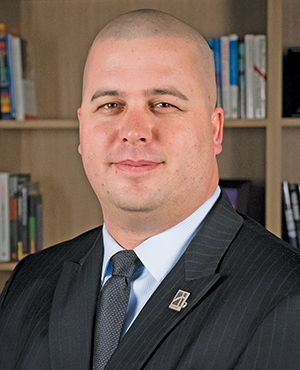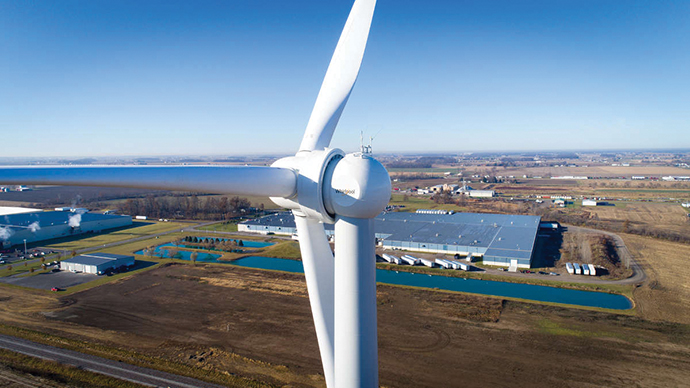Do you know what the price of power will be in 20 years? It’s one of Jereme Kent’s favorite questions. He asks his potential customers, and he’s happy to give them an answer.
Kent, a peripatetic 33-year-old, is founder and CEO of One Energy, a daring and disruptive wind power company in Findlay, Ohio. In a little more than six years, One Energy has grown from a small band of renegades at an edge-of-town strip mall into a force in Ohio’s energy markets. The company now supplies 100 million kilowatt-hours of power annually, says Kent, to some of Ohio’s biggest industrial projects.
One Energy boasts 50 employees (“going up every day,” says Kent), a new 22-000- sq.-ft. (2,044-sq.-m.) corporate office and $100 million worth of operating assets. It keeps a yardful of monstrous, Goldwind turbine parts neatly arranged for deployment. And what says “playa” more than a company chef, one with a fondness for fried prawns and grilled fresh octopus?
But back to the question of power costs. It goes to the heart of One Energy’s business model.

“We had to go where industry was, and we quickly realized how much industry was concentrated in northwest Ohio.”
“We offer a 20-year fixed rate,” says Kent. “We take all capital costs, all operating costs, all production risks. We invest the $3 million or so that it takes per turbine, and the customer doesn’t pay a penny. The only thing the customer pays for is the power we deliver to their factory. If we locked them in right now at five cents per kilowatt-hour,” Kent says, “then 20 years from now they’re still paying five cents, and that’s nowhere near what the grid will be at that point.”
For One Energy’s power-hungry customers, says Kent, it’s an offer that comes with the likelihood of significant, long-term savings.
“We don’t do it because it’s good for the environment, which it is,” Kent says. “We do it because it’s good business. We’re going to take on a fundamental industry and we’re going to change it. We’re going to put the control of power back in the hands of the people who use it. Right now, companies are dependent on utilities. But utilities need to be subservient to the people they deliver for. Our plan is to help companies take control of that, take back control of power just like they would for anything else in their supply chain.”
Breeze Kings
It’s a proposition that works for Whirlpool Corporation, which churns out 15,000 dishwashers a day from its production plant in Findlay. The Whirlpool plant derives upwards of 15 percent of its vast power needs from two One Energy turbines. Three additional turbines, also owned by One Energy, occupy the same 70-acre (28-hectare) plot of land and feed the Ball Corporation’s adjacent beverage packaging plant.
Whirlpool came to view the Findlay arrangement so favorably that it negotiated deals with One Energy to help power its plants in the Ohio towns of Ottawa, Marion and Greenwood. In addition to Whirlpool and Ball, One Energy’s roster of industrial customers includes Ohio’s Cooper Farms, Haviland Plastics and Marathon Petroleum, which powers a pipeline pump station in Harpster with a single One Energy turbine.
Valfilm, a Brazilian-based company that makes film for food packaging, construction and the auto industry, is one of One Energy’s newest customers, having recently ordered two 1.5- megawatt turbines now being erected on 35 acres (14 hectares) just east of its plant in Findlay. The turbines are expected to account for 50-percent of Valfilm’s electricity needs when they’re fired up later this spring, says Steve Shiparski, Valfilm’s Findlay site manager.
Shiparski says wind energy fits well with the company’s environmental profile and should also help to bolster its bottom line.
“We don’t do it because it’s good for the environment, which it is. We do it because it’s good business.”
“Valfilm is a big company in South America, but this is our first foray into North America, and with that being said, we’re almost like a startup. So, cash is king. Optimizing our energy costs is very appealing, especially without a big up-front capital outlay.
“Entering into a 20-year agreement was a little foreboding to a brand new company like ours,” says Shiparski, “but we agreed that it was important for us to drive a stake in the ground. It was almost a symbolic vote for our employees and for the Findlay community that Valfilm is serious about being here.”
Tim Mayle, Director of Findlay-Hancock Economic Development, sees One Energy as a tool in his kit for attracting industrial development, saying the prospect of renewable and predictably affordable electricity has piqued the interest of businesses considering locating and expanding in Findlay.
“I truly view One Energy as an incentive,” says Mayle.
Upsizing into Ohio
A native of southern California, Kent founded One Energy in Minnesota with the aim of powering farms and smaller such installations. Greater ambitions spurred the company’s move, in 2011, to northwest Ohio.
“We realized we wanted to go after larger customers,” Kent tells Site Selection. “That meant we had to go where industry was. We did a whole bunch of research and we quickly realized how much industry was concentrated in northwest Ohio. It’s astronomical. After doing a thorough analysis of wind, transportation, rules and everything tied to the business, we moved to Findlay sight unseen, believing that this is the center of industry and the center of wind in northwest Ohio, whether anybody knows it yet or not. We figured it was time to be here.

“We’ve since realized,” says Kent, “how beneficial Ohio is from the overall business point of view. We have the ability to work with legislators who want to innovate, who want to support industry, who actually say ‘What can we do to help you?’ Good luck with that in most other states,” says Kent. “In Ohio, we’re able to interact with all levels of government and get answers, whether they’re the answers we want to hear or not. That’s key to being able to grow a business like this.”
In a report released in August, the U.S. Department of Energy ranked Ohio 6th in the nation in total wind capacity deployed in “distributed applications,” the technical term for projects, like One Energy’s, that provide power from on-site or nearby. One Energy’s installations fly below a five-megawatt threshold, over which the energy provider is essentially judged to be utility, with the regulatory entanglements that can involve. The smaller approach translates to nimbleness and speed; the company is aiming for a three-month window from the time an order for power is received and the day the juice starts flowing.
“Optimizing our energy costs is very appealing, especially without a big up-front capital outlay.”
Kent believes that Ohio’s flexible net metering laws have helped to make wind power financially potent. Under Ohio law, the only restriction his customers face is not to generate more power than they consume.
“One of the things we look for is the ability to help the customer offset as much of their bill as possible, and you can offset up to your consumption in Ohio. There’s no size limit that’s specific or defined. So, if you’re a home, you can offset a home’s worth of power. If you’re a factory, you can offset a large factory’s worth of power. That’s what Ohio does instead of just picking a number as most states have done. That was attractive to us from the start.”
Wind Blows (Your Job Shouldn’t)
So believes Kent. And no, when the boss throws down for lunch every day, it certainly doesn’t suck. Chef Joseph Jacobsen, “stolen from a major dot-com,” Kent likes to say, is big on cutting sugar out of his co-workers’ diets. He’s most passionate, though, about stretching their culinary boundaries.
“My main focus here is to introduce people to things they’ve never tried before,” Jacobsen tells Site Selection. “I’ve had a lot of people come to me and say they don’t like, for example, octopus. I just say, ‘Well, you’ve gotta try mine.’
“I don’t know how Jereme found me,” laughs Jacobsen. “He sent me an email, and it was obvious that he already knew everything about me.”
Lunch at One Energy might be coconut-crusted lobster bites; garlic braised short ribs with sweet corn succotash; citrus roasted salmon with wild mushrooms and butternut squash; roasted scallops; Ropa Vieja. And, yes, it’s free to employees; wanna-be chefs are welcome to help in the kitchen.
“It’s an open culture,” says Kent. “We have flexible work hours, we have a gym, we have showers on site. No one brings their lunch anymore. We encourage people in the office to go out and learn how to be in the field. We encourage people in the field to learn how to be in the office. We’ve got the kinds of benefits that would stand up to anyone in Silicon Valley any day.”
Also:
“It can be very rewarding to realize that you’re actually changing the way things are made. If you go buy a dishwasher made by Whirlpool, and I don’t care where you are, that dishwasher was made, at least in part, with wind energy here in Findlay, Ohio.
“We’re building a company where our team realizes,” says Kent, “that we are actually moving the needle. People talk about needing to be cleaner, greener, more renewable. We don’t talk about it, we just do it.”

